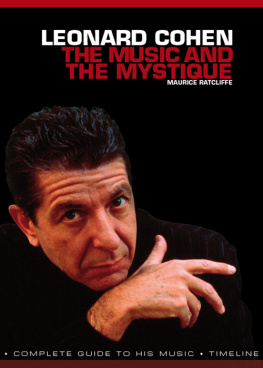THINKING OF OTHERS

PRINCETON MONOGRAPHS IN PHILOSOPHY
Harry G. Frankfurt, Editor

The Princeton Monographs in Philosophy series offers short
historical and systematic studies on a wide variety
of philosophical topics.
Justice Is Conflict by STUART HAMPSHIRE
Liberty Worth the Name: Locke on Free Agency by GIDEON YAFFE
Self-Deception Unmasked by ALFRED R. MELE
Public Goods, Private Good by RAYMOND GEUSS
Welfare and Rational Care by STEPHEN DARWALL
A Defense of Hume on Miracles by ROBERT J. FOGELIN
Kierkegaards Concept of Despair by MICHAEL THEUNISSEN (TRANSLATED BY BARBARA HARSHAV AND HELMUT ILLBRUCK)
Physicalism, or Something Near Enough by JAEGWON KIM
Philosophical Myths of the Fall by STEPHEN MULHALL
Fixing Frege by JOHN P. BURGESS
Kant and Skepticism by MICHAEL N. FORSTER
Thinking of Others: On the Talent for Metaphor by TED COHEN
THINKING OF OTHERS
ON THE TALENT FOR METAPHOR
Ted Cohen
PRINCETON UNIVERSITY PRESS
PRINCETON AND OXFORD
Copyright 2008 by Princeton University Press
Published by Princeton University Press, 41 William Street,
Princeton, New Jersey 08540
In the United Kingdom: Princeton University Press, 6 Oxford Street,
Woodstock, Oxfordshire OX20 1TW
All Rights Reserved
Library of Congress Cataloging-in-Publication Data
Cohen, Ted.
Thinking of others : on the talent for metaphor / Ted Cohen.
p. cm. (Princeton monographs in philosophy)
Includes index.
ISBN 978-0-691-13746-9 (cloth : alk. paper)
1. Metaphor. 2. Empathy. I. Title.
PN228.M4C58 2008
808dc22 2008014920
British Library Cataloging-in-Publication Data is available
This book has been composed in Janson Typeface
Printed on acid-free paper.
press.princeton.edu
Printed in the United States of America
1 3 5 7 9 10 8 6 4 2
This book is for Andy Austin Cohen
SHE DOES A BETTER JOB OF THINKING OF OTHER
PEOPLE THAN ANYONE ELSE I KNOW, DOING IT WITH
UNDERSTANDING AND GENEROSITY BUT WITHOUT
EVER BEING FOOLISH. LIKE ALL PEOPLE, ANDY IS
UNIQUE; AND SHE IS MORE SO.
Contents
CHAPTER ONE
The Talent for Metaphor
CHAPTER TWO
Being a Good Sport
CHAPTER THREE
From the Bible: Nathan and David
CHAPTER FOUR
Real Feelings, Unreal People
CHAPTER FIVE
More from the Bible: Abraham and God
CHAPTER SIX
More Lessons from Sports
CHAPTER SEVEN
Oneself Seen by Others
CHAPTER EIGHT
Oneself as Oneself
CHAPTER NINE
Lessons from Art
CHAPTER TEN
The Possibility of Conversation, Moral and Otherwise
CHAPTER ELEVEN
Conclusion: In Praise of Metaphor
Acknowledgments
Some of the material in this book was published in earlier, different versions, under different titles. Metaphor, Feeling, and Narrative was published in Philosophy and Literature, vol. 21, no. 2 (October, 1997), pp. 22344. Identifying with Metaphor: Metaphors of Personal Identification was delivered as the presidential address to the American Society for Aesthetics in 1998, and subsequently published in the Journal of Aesthetics and Art Criticism, vol. 57, no. 4 (Fall, 1999), pp. 399409. Stories was delivered as the presidential address to the Central Division of the American Philosophical Association in 2007, and subsequently published in Proceedings and Addresses of the American Philosophical Association, vol. 81, no. 2 (November, 2007), pp. 3348.
This small text is much better for having been reviewed by three of the best readers I know, Stanley Bates, Stanley Cavell, and David Hills.
Stanley Bates was once my colleague and has been my friend for decades. Except for Howard Stein, I believe Bates reads and knows more than anyone else I know. He showed me that my central idea is connected to more topics, themes, and problems than I had realized.
Stanley Cavell was once my teacher and has been my friend ever since. Years ago I had the privilege of writing and reading out the citation for him when Cavell received an honorary degree, and I hit on what I thought and think a fitting ascription when I said that he has the courage of his affections. It is this model that has made it possible for eccentrics like me to pursue what appeals to us while supposing that we are still philosophers. In the case of this book, it is Cavell who made me understand that I am taken with and speaking of metaphor not in the narrow sense of that word, but in a much more expanded and ambitious sense, a point that has made my project more difficult and more interesting.
David Hills is a rarity, an absolutely first-class analytical philosopher who reads what you write as if he were a master literary reader. I once published a pair of essays together, one autobiographical and the other straightforwardly analytical, leaving completely unexplained how those two pieces might go together. Whatever success those essays enjoyed, I think almost all readers took them to be independent and separable. When I later met Hills he made clear that he had found exactly why they go together. In reading this manuscript, Hills found more than a few lapses, places in which I settled for a nice idea and a pleasant phrase without supplying a foundation that would support them.
It was a pleasure, of course, and also a relief to know that those three thought the material worth sending out. If you do not think so, you might blame them a little, but you should mainly hold me responsible.
THINKING OF OTHERS

CHAPTER ONE
The Talent for Metaphor
Nonetheless, I agree that there is a pictorial dimension to metaphor and that the perspective it generates cannot be expressed propositionally.
JOSEF STERN
We may, therefore, regard the metaphorical sentence as a Duck-Rabbit; it is a sentence that may simultaneously be regarded as presenting two different situations; looked at one way, it describes the actual situation, and looked at the other way, an hypothetical situation with which that situation is being compared.
ROGER WHITE
There is mystery at the heart of metaphor. During the past several years a number of capable authors have done much to clarify the topic, and they have shown that some earlier central theses about the nature of metaphor are untenable. What they have shown, in particular, is that the import of a significant metaphor cannot be delivered literally, that is, in general, that a metaphorical statement has no literal statement that is its equivalent.
It may or may not be prudent to regard the import of a metaphor as a meaning. If it is, then a metaphorical sentence has two meanings, one literal and one metaphorical. If not, then there is only one meaning, the literal meaning, and the metaphorical import has to be understood in another way. But in either case there will be a metaphorical import that a competent audience will grasp. How the audience does this is, in the end, a mystery.





















